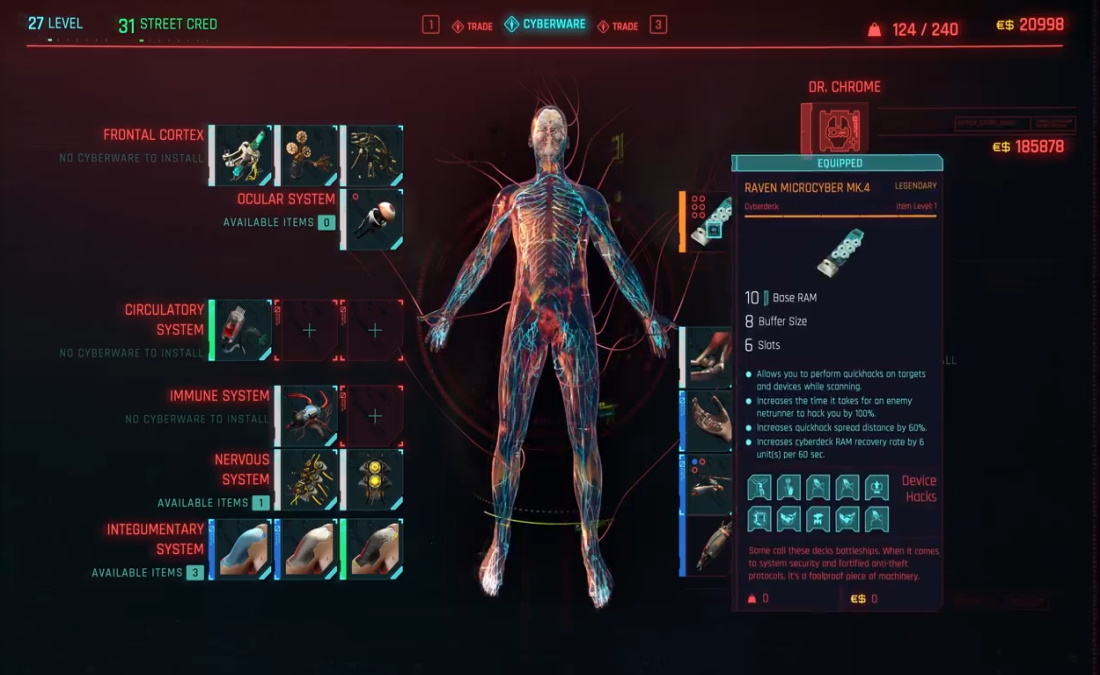Hacking in Cyberpunk 2077 is one of the most useful mechanics in the game, and one you should become familiar with as quickly as possible. Hacking takes two forms: quickhacks, which are mostly used in combat and against enemies, and breach protocol for interfacing directly with computer and machine systems. Here’s how to hack and solve breach protocol puzzles in Cyberpunk 2077.
How to Hack and Solve Breach Protocol Puzzles in Cyberpunk 2077
Quickhacking Explained

Quickhacks, the more active form of hacking you’ll do in Cyberpunk 2077, is based on the quickhacks you equip in your cyberdeck. Higher quality cyberdecks can equip more hacks as well as higher rarity ones. Quickhacks range from simple tasks like deactivating surveillance systems to wipeing and enemy’s memory so they’re not aggressive anymore.
Be aware that, as of update 2.0, many combat quickhacks are now “traceable,” meaning once you use them, if there’s a netrunner in the enemy’s ranks, they can reverse hack you to find your location. As for upgrading your hacking abilies, you’ll want a high Intelligence score. On top of the many different effects you can add to make quickahcks more effective, Intelligence perks also reduce the amount of RAM required to use them, increase their damage, and make them more effective overall.
Naturally, what you can do with through hacking varies depending on the object you scan, (e.g., you can’t do with people what you can with security systems). Aside from offensive quickhacks, the most important thing in your hack scan is obtaining data. The data panel shows you what you get from defeating that enemy, including whether there are any lucrative bounties on them and if defeating them might affect your Street Cred stat.
Bounties often turn up in surprising places, so data scanning is definitely worth your time.
You can obtain more quickhacks in a few ways:
- As rewards for completing missions
- Buying them from ripperdocs or netrunners
- Crafting them after buying a blueprint from a netrunner store
But you’ll be limited in the number you can use at first and how you can use them.
Quickhack Mods
Quickhacks live in your operating system, and Cyberpunk 2077 is full of different mods that can augment your quickhacks. Some increase your RAM, while others activate more than one quickhack simultaneously. It’s worth experimenting with different mods to see what suits your playstyle best.
How to Solve Breach Protocol Hacking Puzzles

The other side to hacking in Cyberpunk 2077 is breach protocol. Actually a numbers mini-game of sorts, and one you’ll often encounter when trying to weaken opponents or access secure terminals. However, some quests involve breach protocol too, including The Pickup.
Cyberpunk 2077 Hacking Minigame: How Breach Protocol Works
When using breach protocol, you’re given a grid of numbers for Cyberpunk 2077’s hacking minigame. There’s a time limit and a set of numbers you need to key in to receive certain rewards, but the order you can select them changes with each selection.
You always start with a horizontal row. After choosing your first number, it switches to vertical. You can only pick a number above or below your first choice, and then it switches back to horizontal again.
For instance, say you start with the first required input, 55, and you need to then reach BD below it, then 1C to the right, then E9 a few spots up. Selecting any of the wrong choices will see you locked to choosing the next from the first column. You can see hout many turns you get underneath the Buffer header, as well as the rewards you’ll receive for completing the minigame in a specific order.
Planning ahead is absolutely essential in these puzzles, though some breach protocol puzzles offer you extra input chances to reach the row or column you need. You also get more time to finish the puzzles and more spare chances with higher intelligence.
That’s very handy for the more complicated breach protocol puzzles that come your way for more important terminals later in the game, so don’t skimp on intelligence if you want a solid hacker build.
That’s all you need to know about how to hack and solve breach protocol puzzles in Cyberpunk 2077. For more Cyberpunk content, check out our guides hub.







Published: Sep 25, 2023 3:29 PM UTC